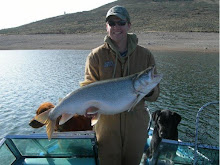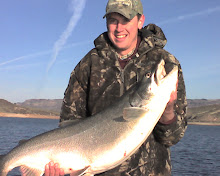Wrong! How long has it been since you have examined the line selection at your local sporting goods or super store? It seems like choosing a line has become worse then picking toilet paper. An entire isle of practically the same thing that will all get the job done, some just might not be nearly as effective. Before we even start, keep in mind that you should be changing your line AT LEAST annually. Fishing line can and will get very brittle and even high pound test will break with just your hands or tying on a lure, even if it has only been used a couple of times. I have seen several fish, including one this last weekend, not only break off, but steal a lure expensive enough to have paid for new line.
So, the first thing to consider is the species of fish you will be fishing for. Keep in mind that the smaller the diameter the easier it will cast. Basically you want the smallest diameter that will still avoid 99% of break offs. I would recommend for trout to start in the 6-8lb test range. Lake trout and Pike will require a heavier line, something in the 12-20lb test range should suffice. Pan fish will only require a 4 or 6 lb test. Now lets talk about different kinds of line. Monofilament is your standard fishing line that granddaddy and dad have been using for years. It is usually the cheapest but still has its place. Mono is still the clearest colored line and is my favorite for super clear water. However, mono is more prone to abrasion so check the last 24" of your line after every fish and re-tie if needed. Mono also stretches so a harder hook set is needed and often is not sensitive enough to fill the bottom with certain techniques like jigging.
The new braided lines are more expensive but are more abrasion resistant. They come in several colors which can be helpful in different water conditions: but one color is not right for every water color which requires more line changing than mono. My favorite is green and I use it in a couple water colors but usually not clear. I prefer braided line for toothier critters as well, because I can get away without a steal leader most of the time. Some of the newer lines also offer a heavier pound test at a small pound test diameter. This is especially helpful when doing a lot of casting. For example my pike set up has a 12lb test braided line which carries a 6lb diameter for casting rocky shore lines. Even with braided line, it is important to check the last 24" of line for nicks and re-tie when you find one or more. Whatever you decided, the cost of a spool of line is something that can easily cover itself in cost, and there is nothing worse than taking a friend or favorite nephew fishing only to have them break several fish off and lose your favorite two lures in the process. So get out there, fishing season in the Rocky Mountains is here. Good luck, cast straight, and set the hook like a monster is on the end.
Tuesday, April 20, 2010
Tuesday, April 6, 2010
Lake Trout I can hear you calling my name!
While these windy days of spring are miserable to work in, they sure help thaw out the lake in a hurry. This means one thing, BIG lake trout in shallow water. I have heard two different reasons why the laker's move shallow in the spring and the fall. One theory I have heard is that the lake trout really like a certain level of oxygen in the water which is constant at a certain temperature, the other is that the bait fish that lake trout eat like a certain temperature of water. Either way, their movement is directly related to temperature. As the lake warms up they will move shallower and shallower until a certain point when they reverse and start moving deeper. During the month after and before ice out, the fish will move all the way to 10' of water or less. When the surface temp hits 50-55 degrees magic starts to happen. Even though these fish are shallow, they will not be caught all over the lake. The old saying, 90% of the fish live in 10% of the water still holds true. The nice thing about big lake trout is they are very predictable and the places they are caught is consistent from year to year. In fact the last two state records where caught within a few yards of each other but two years apart. And don't be afraid to use big bait. It's not uncommon for people to catch fish on 10"-12" whole suckers or 3oz jigs. The best part is, as soon as the fishing on blue mesa starts to slow, Taylor is just getting started. There is really 2 good months of lake trout fishing between the two lakes. So get your rods and reels out of the closet, it's fishin time!
Subscribe to:
Comments (Atom)





